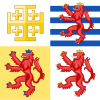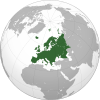| Flag
|
Date
|
Use
|
Description
|

|
1912–
|
Flag of Albania
See also: List of Albanian flags
|
The flag of Albania, adopted in April 1912, is a red flag with a black double-headed eagle in the centre. It is derived from the seal of Gjergj Kastriot Skanderbeg, a 15th-century Albanian who led a revolt against the Ottoman Empire that resulted in brief independence for Albania from 1443 to 1478.
|

|
1866–
|
Flag of Andorra
See also: List of Andorran flags
|
The flag of Andorra, adopted in 1866, is a tricolour of blue, yellow, and red with the coat of arms of Andorra in the centre. It is based on the flags of France and Spain. The coat of arms of Andorra is based on the flag of Catalonia (4 red ribbons on yellow background).
|

|
1918–1920
1991–
|
Flag of Armenia
See also: List of Armenian flags [note 3]
|
After gaining independence, the First Republic of Armenia adopted the modern Armenian tricolor. The independent Armenian government selected the colours used during the last period of the Rubenid Dynasty: red, blue and orange. The red emblematizes the Armenian Highland, the Armenian people's continued struggle for survival, maintenance of the Christian faith, Armenia's independence and freedom. The blue emblematizes the will of the people of Armenia to live beneath peaceful skies. The orange emblematizes the creative talent and hard-working nature of the people of Armenia.
|

|
1918–1938
1945–
|
Flag of Austria
See also: List of Austrian flags
|
Originally adopted in 1918, it was again officially adopted in 1945, after being banned during World War II.
Stripes of red and white have been a collective emblem of Austria for over 800 years, and they were first used on the flag in 1191. According to long-established legend, the red and white flag was designed to resemble the bloodstained white coat worn by the Duke of Austria during a fierce battle.
|

|
1918–1920
1991–
|
Flag of Azerbaijan
See also: List of Azerbaijani flags [note 3]
|
Originally adopted in 1918 as a flag of the Democratic Republic of Azerbaijan, it was officially adopted again in 1991, after Azerbaijan gained its independence.
The flag of Azerbaijan is the national ensign of Azerbaijan. It consists of three equal horizontal bands colored blue, red, and green, with a white crescent and an eight-pointed star centered in the red band. The blue band refers to Turkic heritage, the red is for progress and Europeanisation and the green refers to Islam.
|

|
1995–
|
Flag of Belarus
See also: List of Belarusian flags
|
Belarus's flag was officially adopted on 10 February 2012. The dominant red-green bicolour was used on its flag when it was a republic within the former Soviet Union. The woven fabric ornament on the left uses traditional Belarusian red and white colours.
|

|
1830–
|
Flag of Belgium
See also: List of Belgian flags
|
Black, gold and red are symbolic of the country's coat of arms. The three-striped vertical layout was inspired by the French Tricolour. Black and gold were chosen, being the colours of the Duchy of Brabant where the Belgian Revolution started. Red was added as a symbol of the blood spilled during the uprising.
|

|
1998–
|
Flag of Bosnia and Herzegovina
See also: List of flags of Bosnia and Herzegovina
|
The flag of Bosnia and Herzegovina consists of a wide medium blue vertical band on the fly side with a yellow isosceles triangle abutting the band and the top of the flag. The remainder of the flag is medium blue with seven five-pointed white stars and two half stars top and bottom along the hypotenuse of the triangle. The three points of the triangle stand for the three nations of Bosnia: Bosniaks, Croats, and Serbs. It is said to represent the map of Bosnia.
|

|
1878–1947
1991–
|
Flag of Bulgaria
See also: List of Bulgarian flags
|
The flag of Bulgaria was adopted in 1989 and consists of three horizontal bands of white, green and red.
|

|
1990–
|
Flag of Croatia
See also: List of Croatian flags
|
The flag of Croatia, adopted in December 1990, consists of three equal horizontal stripes of red, white and blue and the coat of arms of Croatia in the center.
|

|
1960–
|
Flag of Cyprus
See also: List of Cypriot flags [note 4]
|
The flag was officially adopted on 16 August 1960.
The island is depicted in a copper shade representative of its name: the name Cyprus has roots in the Sumerian word for copper (zubar), from the large deposits of copper found on the island. The crossed green olive branches symbolise the hope for peace between the Turks and the Greeks. It was designed by İsmet Güney, a Turkish Cypriot painter.
|

|
1993–
|
Flag of the Czech Republic
See also: List of Czech flags
|
The first flag of Czechoslovakia was white over red, and those colours are the heraldic colours of Bohemia. The blue triangle was added to the flag to distinguish it from the flag of Poland, and blue is said to represent the State of Moravia.
|

|
1219–
|
Flag of Denmark
See also: List of Danish flags
|
It is the world's oldest state flag still in use. Legend has it that it appeared as a sign from heaven to King Valdemar II in 1219.
Known as the Dannebrog ("Danish Cloth"), this blood-red flag with an off-centred white cross (a "Nordic Cross") became a model for other regional flags.
|

|
1918–1940
1990–
|
Flag of Estonia
See also: List of Estonian flags
|
It was officially re-adopted on 8 May 1990. The story of the flag begins on 17 September 1881, when the constituent Assembly of the first Estonian national student Corps "Vironia" (modern Estonian Students Society) in the city of Tartu was also identified in color; it later became national. The first flag was made in 1884 and this tricolour was accepted in 1918 as the national flag of Estonia. The original flag is still in existence. The first flag of Estonia is kept in Tartu Estonian National Museum.
Blue represents loyalty, and the country's beautiful blue skies, seas and lakes; black is symbolic of past oppression and the fertile soil; and white represents virtue, winter snows, and Estonia's long struggle for freedom and independence.
|

|
1918–
|
Flag of Finland
See also: List of Finnish flags
|
It was officially adopted on 29 May 1918.
The off-centred blue cross is based on the Nordic Cross, widely used on Nordic national flags. The blue colour is symbolic of blue skies, and the thousands of lakes in Finland. The white represents the winter snows.
|

|
1794–1814
1830–
|
Flag of France
See also: List of French flags
|
It was officially adopted on 15 February 1794.
The tricolore consists of three vertical bands of equal width, displaying the country's national colours: blue, white, and red. The blue band is positioned nearest the flagstaff, the white in the middle, and the red on the outside. Red, white and blue have come to represent liberty, equality and fraternity—the ideals of the French Revolution. Blue and red are also the time-honoured colours of Paris, while white is the colour of the Royal House of Bourbon.
|

|
2004–
|
Flag of Georgia
See also: List of Georgian flags [note 3]
|
This recently adopted flag is a simple white rectangle, with a central red cross connecting all four sides of the flag; in each of the four corners is a small red cross. The flag is based on a historic five-cross design that dates back to the 14th century.
|

|
1919–1933
1949–
|
Flag of Germany
See also: List of German flags
|
It was officially re-adopted on 23 May 1949, and subsequently used by West Germany while the country was divided into East and West before reunification in 1990.
The tricolour flag was designed in 1832, and the black, red, and gold colours were taken from the uniforms of German soldiers during the Napoleonic Wars (Out of the blackness (black) of servitude through bloody (red) battles to the golden (gold) light of freedom.[1]) or taken from the coat of arms of Holy Roman Empire.
|

|
1978–
(Civil flag since 1822)
|
Flag of Greece
See also: List of Greek flags
|
The current flag of Greece was adopted as a civil flag and ensign in 1822, and as the national flag in 1978.
It features a white cross and a combination of nine (five blue and four white) horizontal stripes. The shade of blue has varied over the years, and darker blue (shown) is now commonly used. The alternating white and blue stripes are said to represent the nine syllables of the phrase "Eleftheria i thanatos" ("Freedom or Death"), a popular motto during the Greek War of Independence. During the Kingdom of Greece, a crown was added in the centre of the cross.
Greece's national flag between 1822 and 1970 featured a simple white cross on a blue background. It is not known why this version was adopted, and not a blue cross on a white background as was popular in the War of Independence. During the dictatorship, a navy blue version of the current flag with proportions of 7:12 was used.
|

|
1957–
|
Flag of Hungary
See also: List of Hungarian flags
|
The flag of Hungary was officially adopted in 1848.
The dominant red, white and green colors of the tricolour design are derived from the historical Hungarian coat of arms. Red is said to symbolise strength, white faithfulness, and green hope.
|

|
1915–
|
Flag of Iceland
See also: List of Icelandic flags
|
The flag of Iceland was adopted in June 1915 to represent Iceland. In June 1944 it became the flag of the independent republic of Iceland. Like other Scandinavian flags, it is based on the Nordic Cross. It is a reverse colour image of the Flag of Norway. The blue represents the sea, the white represents the snow and glaciers and the red symbolises volcanic lava.
|

|
1922–
|
Flag of Ireland
See also: List of Irish flags
|
Although dating from the 19th century, the tricolour flag of Ireland was not popularised until its use by rebels during the 1916 Easter Rising. It was officially adopted by the revolutionary First Dáil (assembly) of the Irish Republic on 21 January 1919, and used thereafter by the Irish Free State. The current 1937 Constitution of Ireland defines it as the national flag.
Modeled after the French tricolour, the colours of the Irish tricolour symbolise two communities. Green represents the Roman Catholic nationalist tradition. Orange represents the Protestant unionist community. White symbolises peace between both.
|

|
1948–
|
Flag of Italy
See also: List of Italian flags
|
Derived from an original design by Napoleon, it consists of three vertical bands of equal width, displaying the national colours of Italy: green, white, and red. Green stands for hope, white for loyalty and red represents the blood spread to unify the country.
|

|
1992–
|
Flag of Kazakhstan
See also: List of Kazakh flags [note 5]
|
Adopted on 4 June 1992. The flag has a gold sun with 32 rays above a soaring golden steppe eagle, both centered on a teal background; the hoist side displays a national ornamental pattern called "koshkar-muiz" (the horns of the ram) in gold.
|

|
1918–1940
1990–
|
Flag of Latvia
See also: List of Latvian flags
|
The flag of Latvia was officially re-adopted on 27 February 1990.
The design is adopted from a 13th-century chronicle where "red divided by white" is said to be a Latvian flag. To distinguish it from the Austrian flag, the proportions 2:1:2 and the "Latvian red" color have been adopted.
|

|
1937–
|
Flag of Liechtenstein
See also: List of Liechtensteinian flags
|
The flag of Liechtenstein consists of two horizontal bands of blue and red with a gold crown in the canton. The crown was added to the flag in 1937 after the country found out at the 1936 Summer Olympics that their flag was identical to the civil flag of Haiti.
|

|
1918–1940
1989–
|
Flag of Lithuania
See also: List of Lithuanian flags
|
The flag of Lithuania was officially re-adopted on 20 March 1989, before Lithuania gained independence from the Soviet Union in 1990.
Yellow is symbolic of the country's wheat fields, green symbolic of the forests, and red symbolises patriotism. Collectively the colours represent hope for the future, freedom from oppression, and the courage of the Lithuanian people.
|

|
1845–
|
Flag of Luxembourg
See also: List of flags of Luxembourg
|
The flag of Luxembourg was officially adopted in 1972, although it had been used since 1848 following Luxembourg's independence from the Netherlands in the late 19th century.[dates disagree]
The flag uses a combination of red, white, and blue that dates to the 13th century, and the Grand Duke's coat of arms.
|

|
1964–
|
Flag of Malta
See also: List of flags of Malta
|
The flag of Malta was officially adopted on 21 September 1964.
The flag uses the traditional red and white colours which pre-date those of the Knights of Malta and which Government emulate[clarification needed] the arms of the former Universitas of Mdina. The George Cross (upper left), outlined in red, was added to the flag in the 1940s, as King George VI of the United Kingdom presented it to islanders for outstanding gallantry during World War II.
|

|
1990–
|
Flag of Moldova
See also: List of Moldovan flags
|
Moldova's flag was officially adopted on 12 May 1990. Once part of Romania, Moldova's flag reflects that association, as the two countries use almost identical shades of red, yellow and blue in their national flags. The centred Moldova shield's main feature is a golden eagle holding an Orthodox Christian Cross in its beak. The olive branch is said to symbolise peace.
|

|
1881–
|
Flag of Monaco
See also: List of flags of Monaco
|
The flag of Monaco has two horizontal bands of red and white—these have been the heraldic colours of the House of Grimaldi since at least 1339.
|

|
2004–
|
Flag of Montenegro
See also: List of flags of Montenegro
|
The flag of Montenegro, adopted in July 2004, is a red banner bearing the coat of arms adopted in 1993. The country's coat of arms is derived from those of King Nikola.
|

|
1575 (first used)
1937 (officially adopted)–
|
Flag of the Netherlands
See also: List of flags of the Netherlands
|
The flag of the Netherlands was officially adopted on 19 February 1937.
At one time this tricolour flag was orange, white, and blue, as those were the livery colours of William of Orange, a Dutch prince. In the 17th century, red replaced the orange as a flag colour, because the orange dye used on the flag was unstable, and turned red after exposure to the sun. It is the oldest tricolour flag still in national use[2] and has influenced both the French[3] (1794) and Russian flag[4] (1693); both of these flags have in turn influenced many other European and African flags.
|

|
1995–
|
Flag of North Macedonia
See also: List of flags of North Macedonia
|
The flag of North Macedonia depicts a rising yellow sun with eight rays extending to the edges of the red field. It represents "the new sun of liberty", evoked in the Macedonian national anthem Denes nad Makedonija (Today Over Macedonia).
|

|
1821–1844
1898–
|
Flag of Norway
See also: List of flags of Norway
|
The flag of Norway is red with a blue Nordic cross outlined in white; the vertical part of the cross is shifted to the hoist side in the style of the Dannebrog, the flag of Denmark. It was adopted in 1821, but a union mark was added in the canton from 1844 to 1898.
|

|
1919–
|
Flag of Poland
See also: List of Polish flags
|
The flag of Poland was officially adopted on 1 August 1919.
The colours red and white have long been associated with Poland and its coat of arms, at least since 3 May 1791.
|

|
1911–
|
Flag of Portugal
See also: List of Portuguese flags
|
The flag of Portugal was officially adopted on 30 June 1911.
The design is a rectangular bi-colour (2:3 ratio) with a field vertically divided into two stripes of different widths—a green stripe on the hoist, and a larger red stripe on the fly. A small version of the national coat of arms (armillary sphere and Portuguese shield) is superimposed over the boundary between the colours at equal distance from the upper and lower edges. The field colours, especially the green, originally represented a radical republican-inspired change that broke the bond with the former religious monarchical flag. In the ensuing decades, these colours were popularly propagandised as representing the hope of the nation (green) and the blood (red) of those who died defending it, as a means to endow them with a more patriotic and dignified, therefore less political, sentiment.
|

|
1848
1867–1948
1989–
|
Flag of Romania
See also: List of Romanian flags
|
The flag of Romania was officially re-adopted in 1989. The first red-yellow-blue flag dates from 1834 but the colours themselves are thought to have had special significance from earlier times. The current layout dates since 1848.
A vertical tricolour of bands of blue, yellow, and red of equal width and overall proportions of 2:3 (height-width).
|

|
1883–1918
1993–
|
Flag of Russia
See also: List of Russian flags [note 6]
|
The Russian Federation flag was officially adopted on 22 August 1991. The flag was hoisted shortly after the former Soviet Union collapsed. The white, blue and red are Pan-Slavic colours.
|

|
2011–
|
Flag of San Marino
See also: List of Sammarinese flags
|
The flag of San Marino comprises equal horizontal bands of white and light blue with the national coat of arms superimposed in the centre.
|

|
1815–1918 (original design)
2004–
(Civil flag since 1835)
|
Flag of Serbia
See also: List of flags of Serbia
|
The flag of Serbia consists of three horizontal bands of red, blue and white, with the coat-of-arms located left of centre. By accident or design the colours are that of the Russian flag reversed. A flag with three horizontal bands of red, blue and white has been used as the national flag of Serbia and Serbs since 1815. Red, blue, and white are considered Pan-Slavic colours, but red and blue also occur on flags attributed to a 13th-century king of Serbia. The superimposed coat of arms of Serbia is a double-headed white eagle and a red shield with a white cross surrounded by 4 firesteels (ocila), a symbol that draws roots from Saint Sava Serbian Cross and from the ancient past of the Balkan peninsula, as it can be seen on 7000 years old Vinča culture pottery and many other later traditional Balkan cultural remains.
|

|
1992–
|
Flag of Slovakia
See also: List of Slovak flags
|
The flag of Slovakia was officially adopted on 1 September 1992.
White, blue and red are traditional Pan-Slavic colours. The superimposed Slovakian arms feature a dominant white cross atop a blue symbolic reference to the European country's mountains.
|

|
1991–
|
Flag of Slovenia
See also: List of Slovenian flags
|
The flag of Slovenia was officially adopted on 24 June 1991.
Red, white, and blue are taken from the Carniolan coat of arms. The flag without the coat of arms was in use from 1848 to 1945. The Slovenian coat of arms features three gold stars, symbolizing the Counts of Celje. The mountains shown in white are representative of the Alps, and Mount Triglav, Slovenia's national symbol, in particular; the wavy blue lines across the bottom indicate Slovenia's access to the sea.
|

|
(1785 original design)
1981–
|
Flag of Spain
See also: List of Spanish flags
|
The flag of Spain was officially adopted on 19 July 1927 as the merchant naval flag, and on 29 December 1978 as the national flag under the current Spanish Constitution. However the first original reference dates back to 15 May 1785, when Charles III of Spain adopted one of the designs proposed by Antonio Valdés y Bazán, commissioned by the king himself, in order to easily differentiate his ships from those of other European nations, many of which used the royal coat of arms over a white background, i.e. the French Bourbon royal flag. The red and golden-yellow colours were used from that day with mere changes[clarification needed] on the coat of arms (with the exception of the Spanish Second Republic) and are the original colours found within the coat of arms of the medieval kingdoms of Castile, Aragon and Navarre, first united by King Ferdinand II of Aragon and Queen Isabella I of Castile.
|

|
(1569–1814)
1906– [5]
|
Flag of Sweden
See also: List of Swedish flags
|
The flag of Sweden was officially adopted on 22 June 1906.
The off-centre yellow cross (the Nordic Cross) is taken from the Danish flag. The yellow and blue colours are taken from the national coat of arms.
It was adopted in 1569, but a union mark was added in the canton from 1844 to 1905.
|

|
1889–
|
Flag of Switzerland
See also: List of Swiss flags
|
The flag of Switzerland consists of a red square with a bold, equilateral white Greek cross in the centre. It is one of only two square flags, the other being that of the Vatican City or Holy See. It is based on the flag of the Canton of Schwyz, which dates back to 1474 at least.
|

|
1844–
|
Flag of Turkey
See also: List of Turkish flags [note 7]
|
The flag of Turkey is a red flag with a white crescent moon and a star in its centre. The flag is called Ay Yıldız (literally, moon star) or Albayrak (Red flag). It was adopted in 1844 with the Tanzimat reforms; though the shape, placement and shade of the colour[clarification needed] vary. The geometric proportions of the flag were legally standardised with the Turkish Flag Law in 1936.
|

|
1918–1920
1992–
|
Flag of Ukraine
See also: List of Ukrainian flags
|
Ukraine's flag was adopted on 4 September 1991, shortly after the collapse of the former Soviet Union. This is the country's original flag used by the short-lived Ukrainian People's Republic, but it was banned for many decades under the Soviet regime. The shade of blue is said to be symbolic of the sky, while the yellow represents Ukraine's golden wheat fields.
|

|
1801–
|
Flag of the United Kingdom
See also: List of United Kingdom flags
|
The current flag of the United Kingdom dates from the Act of Union 1800, which merged the Kingdom of Great Britain and the Kingdom of Ireland to form the United Kingdom of Great Britain and Ireland.
The "Union Jack" merges the red cross of Saint George (patron saint of England), edged in white, superimposed on the diagonal red cross of Saint Patrick (patron saint of Ireland), which are superimposed on the saltire of Saint Andrew (patron saint of Scotland). The flag of Wales, the other country of the United Kingdom, is not graphically represented.
|

|
1929–
|
Flag of Vatican City or Holy See
See also: List of Vatican flags
|
The flag of Vatican City or Holy See, adopted in June 1929, consists of two vertical bands of yellow and white with the crossed keys of Saint Peter and the Papal Tiara centred in the white band. It is one of only two square country flags in the world, the other being that of Switzerland.
|






























































































































































































































































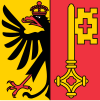




































![Flag of Baku, Azerbaijan[a]](https://upload.wikimedia.org/wikipedia/commons/thumb/4/48/Flag_of_Baku%2C_Azerbaijan.svg/180px-Flag_of_Baku%2C_Azerbaijan.svg.png)
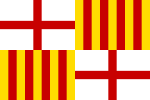

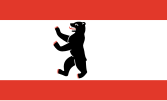





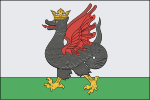

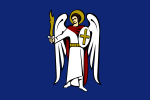
![Flag of the City of London, United Kingdom[note 10]](https://upload.wikimedia.org/wikipedia/commons/thumb/c/c7/Flag_of_the_City_of_London.svg/167px-Flag_of_the_City_of_London.svg.png)





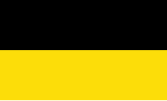


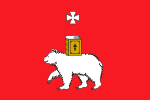
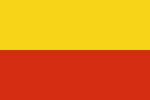




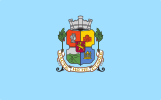
![Flag of Tbilisi, Georgia[note 3]](https://upload.wikimedia.org/wikipedia/commons/thumb/3/31/Flag_of_Tbilisi.svg/179px-Flag_of_Tbilisi.svg.png)





![Flag of Yerevan, Armenia[note 3]](https://upload.wikimedia.org/wikipedia/commons/thumb/4/43/Flag_of_Yerevan.svg/180px-Flag_of_Yerevan.svg.png)






























